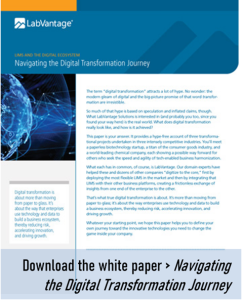 Digitization of your lab’s data is increasingly vital to performance and profitability. Today, that data represents a business advantage. Tomorrow, it’s likely to be mission-critical – or even existential.
Digitization of your lab’s data is increasingly vital to performance and profitability. Today, that data represents a business advantage. Tomorrow, it’s likely to be mission-critical – or even existential.
Digital transformation (DT) is more than a buzzword – it has become a way of life for companies seeking to find and maintain a qualitative edge.
In an analysis of business themes, IBM’s Institute for Business Value (IBV) found that DT “stood out as a ‘mega trend,’ framing our understanding of all the others. Rapid digital transformation fueled by cloud, artificial intelligence (AI) and other technologies like the Internet of Things (IoT) is here to stay — so don’t expect life to slow down.”
The advantages of going digital are significant. It enables improvement in the quality of your data and increases your lab’s efficiency. Digital data is easier for the right people to find when they need it most. It also offers the advantages that come when it can be collected, collated and used in real time. Labs also benefit from lower costs, as well as stronger traceability and accountability.
At the same time, it’s important to understand that digital transformation means more than just converting your data into an electronic format.
Beware the Lure of Spreadsheets
One of the most common traps labs fall into when attempting to make the transition to digital on a budget is to simply switch from using paper to storing data in Excel spreadsheets.
On the surface, this seems like a logical notion. After all, a spreadsheet offers a taste of digital advantages compared to hand-written data, such as minimizing human errors in formula calculation. They’re flexible, easy to use, and don’t require a lot of training to master. They also have the virtue of being cheap.
 The trouble with this approach is that spreadsheets aren’t very efficient for professional lab work. What’s more, in certain industries they create regulatory concerns.
The trouble with this approach is that spreadsheets aren’t very efficient for professional lab work. What’s more, in certain industries they create regulatory concerns.
As easy as spreadsheets are to use, they also make transcription errors more likely to occur. They also open the door to data falsification. To make matters worse, standard Excel spreadsheets lack the robust security many labs require, and have significant drawbacks when it comes to traceability. For example, who made a change? When did the change occur?
In the bio/pharmaceutical industry, for example, these data integrity shortcomings have led many companies to eliminate, or make plans to eliminate, Excel spreadsheets from many critical areas of their business.
Proponents of spreadsheets often try to defend them by pointing out that they can be validated in GMP/GXP environments. Unfortunately, it’s not an easy thing to do, nor is it something you should try without considerable experience navigating the Code of Federal Regulations – and deep knowledge of Excel itself. In some circumstances, the validation process also requires the spreadsheet be linked to a signed paper printout — a cumbersome extra step which arguably defeats the purpose of digitization in the first place.
Even if you feel confident in the integrity of your Excel compliance, you may find it difficult to convince inspectors and auditors. And if they find a single error in spreadsheet, you can bet they’ll start digging for others.
In a detailed article on the pitfalls of spreadsheets, the journal Spectroscopy cited eleven reasons why spreadsheets have no business being used in a regulated laboratory. These run the gamut from regulatory risks to lack of business efficiency, the potential hazards of Excel’s built-in macro language, and the risk that archived spreadsheets may be unreadable by future versions of the software.
Cumbersome Customization
Another intermediate step to digital transformation that many labs end up struggling with is the home-grown LIMS. Labs that try this approach typically get there in one of two ways:
- After suffering the complications of using Excel described above, they decide to build their own in-house LIMS, or
- They are grappling with an earlier decision to build a home-grown system from scratch or to heavily-customize an existing commercial application.
Although either of these paths to a DIY LIMS is a better option than Excel spreadsheets, both are far harder to successfully implement. They also introduce tremendous longevity problems – which only become more complicated, frustrating and expensive over time.
 Let’s start with the problem of expertise. While a home-grown or customized LIMS can potentially avoid the problems associated with Excel spreadsheets, achieving this goal is only possible if you have the scientific, regulatory, business, and technical expertise to do so. Outsourcing the skills you don’t have just to build an in-house system tends to be very expensive.
Let’s start with the problem of expertise. While a home-grown or customized LIMS can potentially avoid the problems associated with Excel spreadsheets, achieving this goal is only possible if you have the scientific, regulatory, business, and technical expertise to do so. Outsourcing the skills you don’t have just to build an in-house system tends to be very expensive.
Once you have all the necessary resources, the next challenge is actually building the system, which can be quite time consuming. But the real problems only come to light once the system is up and operational. Maintaining the system becomes an ongoing challenge. Those upfront costs which looked artificially cheaper back when the whole process started begin to compound. If you’re in a GMP environment, you also have to deal with validation. And every patch or upgrade risks a cascade of system failures elsewhere.
Over time, heavily custom-coded LIMS applications like these introduce new complications. Many of these are similar to the downsides of not updating any electronic system. Common concerns include loss of security, growing challenges with regulatory compliance, and technical malfunctions. Compatibility issues caused by code-heavy applications that were designed to run on older operating systems and legacy instruments are another frequent headache.
 The bigger problem is that heavily custom-coded applications are difficult to update. Bringing them up to speed with modern instruments and capabilities can require them to be rewritten every time they’re updated. This is not just expensive and difficult to accomplish — it’s a recipe for a never-ending battle just to catch up with technology.
The bigger problem is that heavily custom-coded applications are difficult to update. Bringing them up to speed with modern instruments and capabilities can require them to be rewritten every time they’re updated. This is not just expensive and difficult to accomplish — it’s a recipe for a never-ending battle just to catch up with technology.
Where a Contemporary LIMS Shines
Although digitization of information is a necessary first step when it comes to moving your lab forward, it can’t be the only step you take. Compared to the stress-inducing alternatives mentioned above, there are many reasons why implementing a modern, integrated LIMS is a worthwhile investment.
For one thing, you get to keep all the things that made your homegrown LIMS great to start with — and not just when you first implemented the system, but over time. You’ll enjoy improved efficiency and productivity, especially when it comes to data entry, integrating instruments, ERP integration, and quality reviews. You’ll benefit from standardization of your workflows, plus improved consistency, accuracy, reliability and data transparency.
 The longevity of these benefits is made possible by the approach of making LIMS systems configurable (as opposed to customizable). This enables you to tailor the software to your specific needs, and to change it over time as your needs change, without the cost, hassles, and upgrade risks associated with custom programming.
The longevity of these benefits is made possible by the approach of making LIMS systems configurable (as opposed to customizable). This enables you to tailor the software to your specific needs, and to change it over time as your needs change, without the cost, hassles, and upgrade risks associated with custom programming.
And finally, there are powerful new capabilities that only a modern LIMS can offer, which can make your lab significantly more efficient, productive, and profitable while minimizing your risks. These include ongoing improvements in data security, advanced analytics, an integrated Scientific Data Management System (SDMS), cloud hosting options, and tools for ensuring compliance with regulations like GMP, CLIA, ISO, and HIPAA.
With a truly state-of-the-art system like LabVantage LIMS, you’ll also benefit from native integrations with the latest instrument interfaces and external control applications and improved data-driven collaboration and decision-making power, plus single, regional, or global data consistency and integration. In addition, software as a service (SaaS) pricing models are available to minimize your up-front costs, maximize uptime, and relieve your lab from ongoing maintenance and cybersecurity hassles.
To learn more about your digital transformation options, contact LabVantage today.



